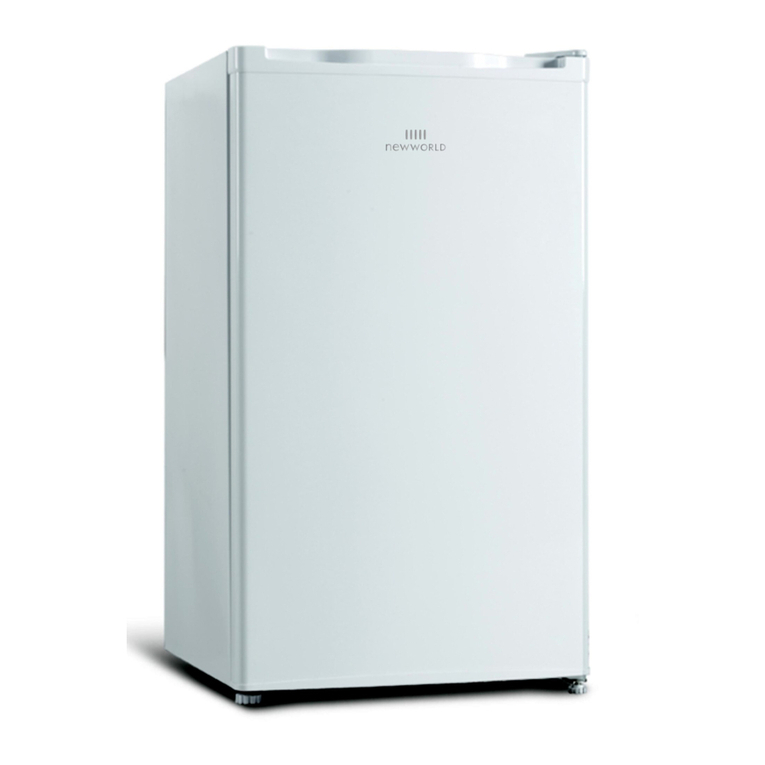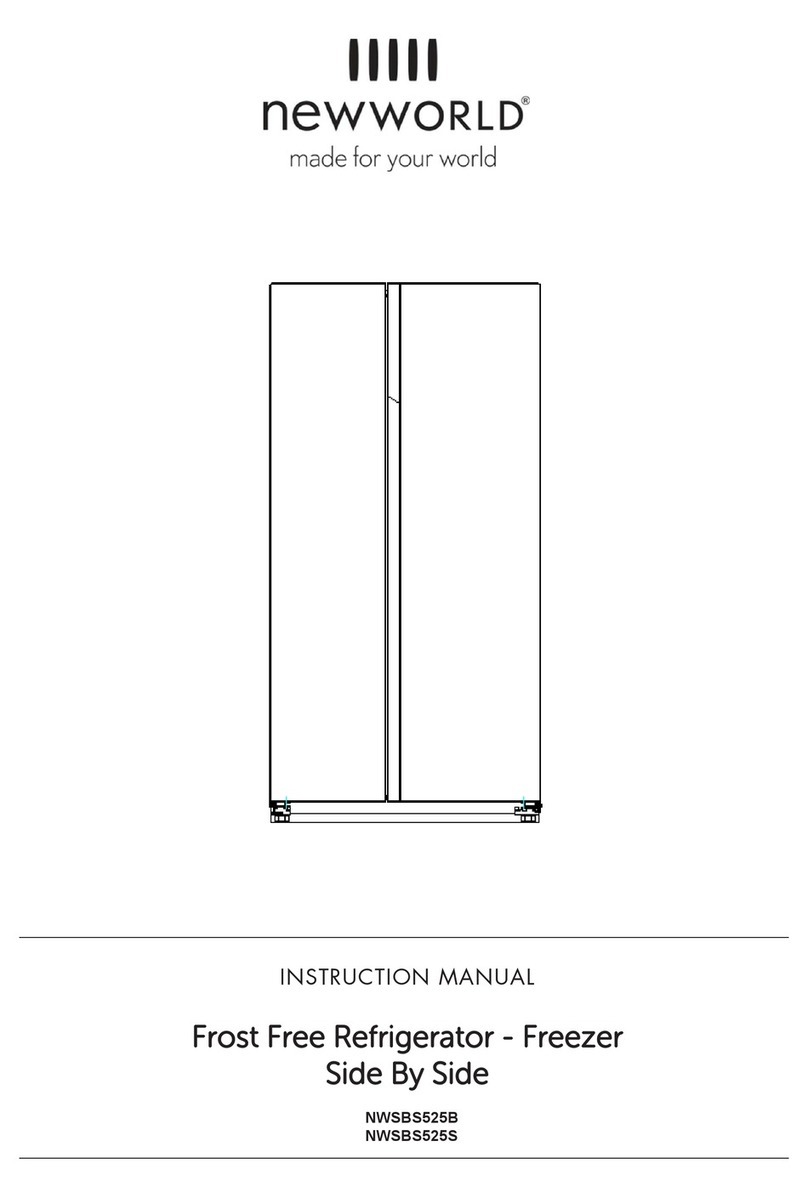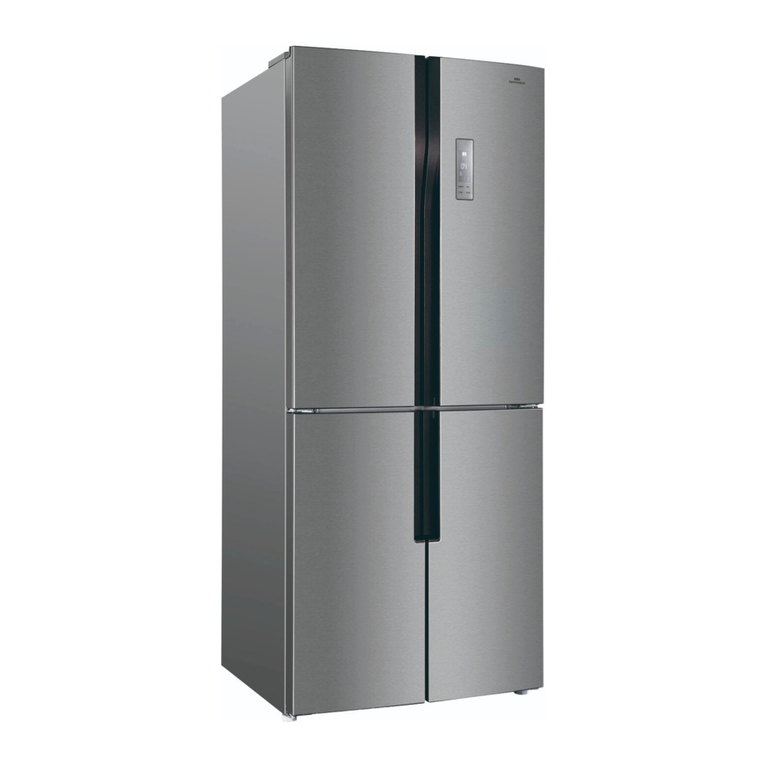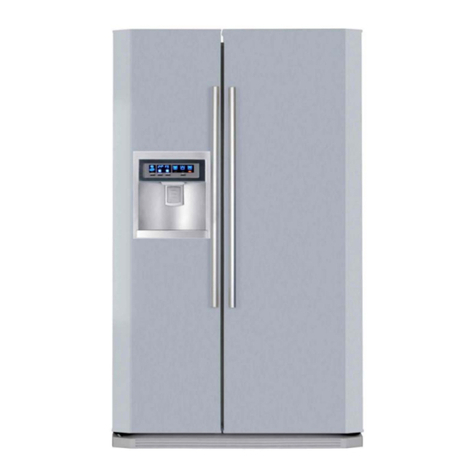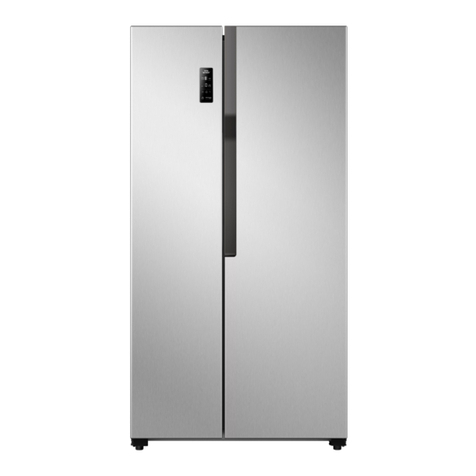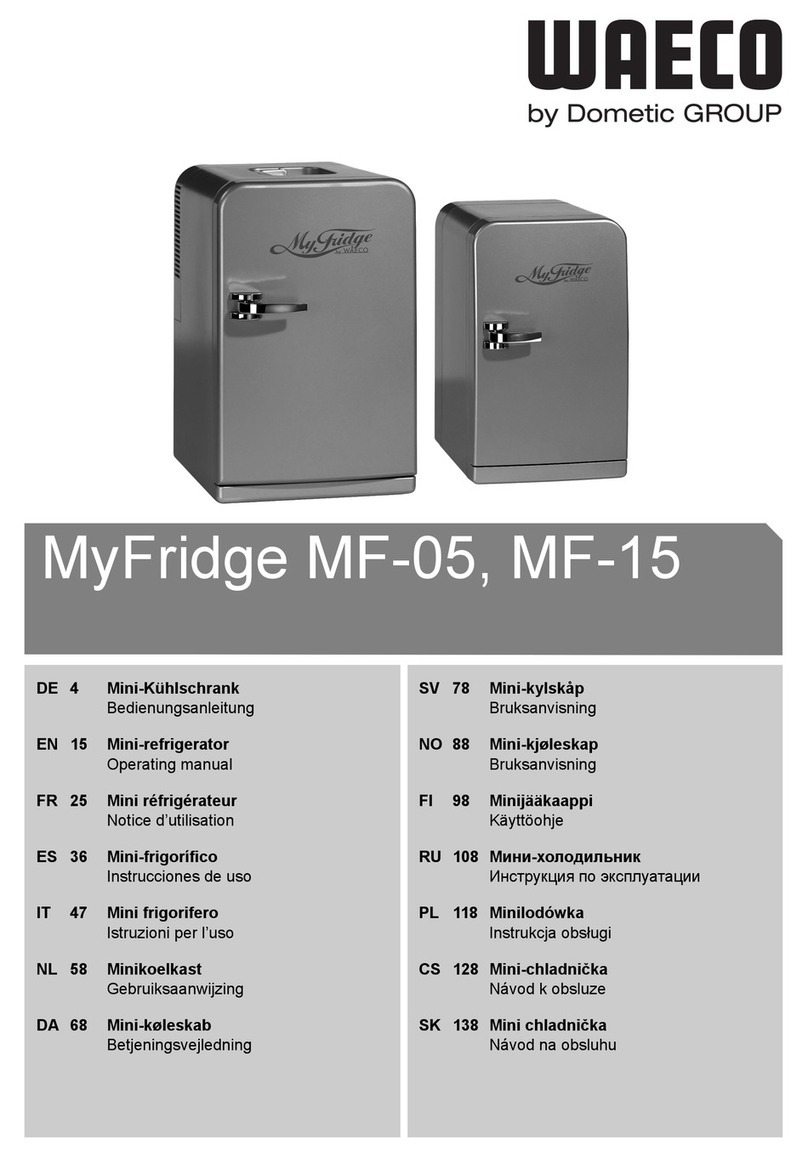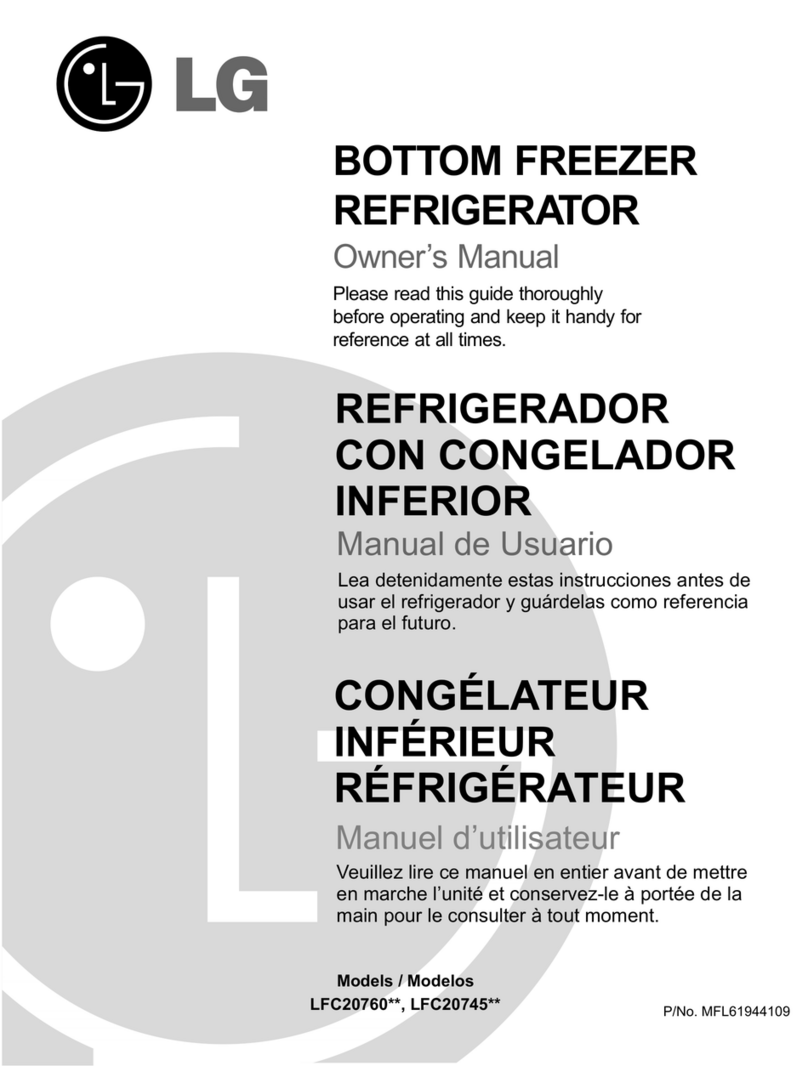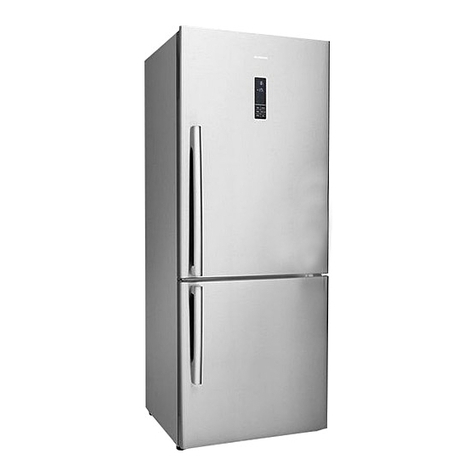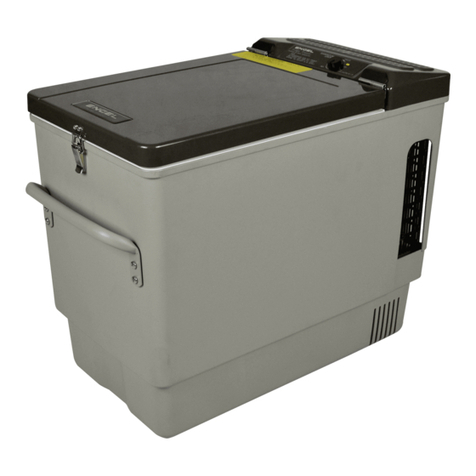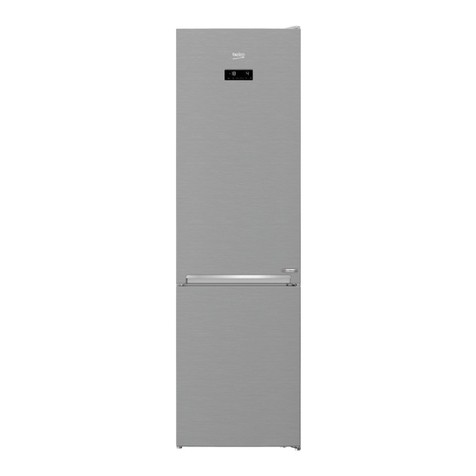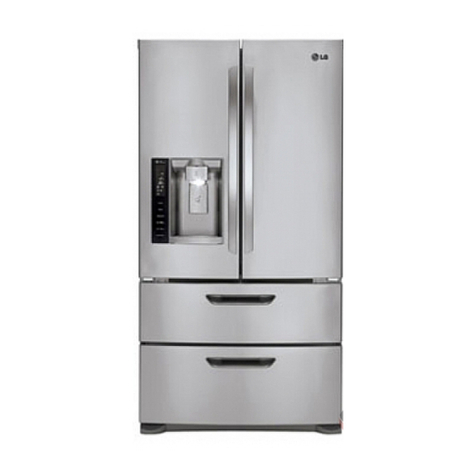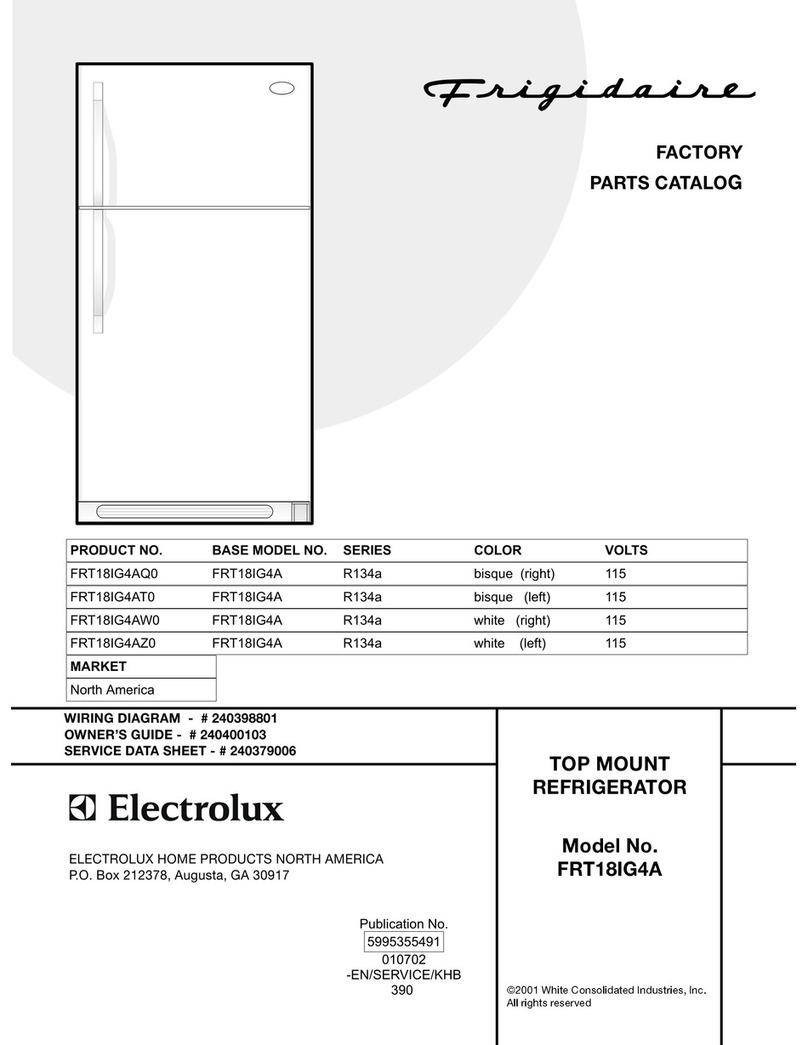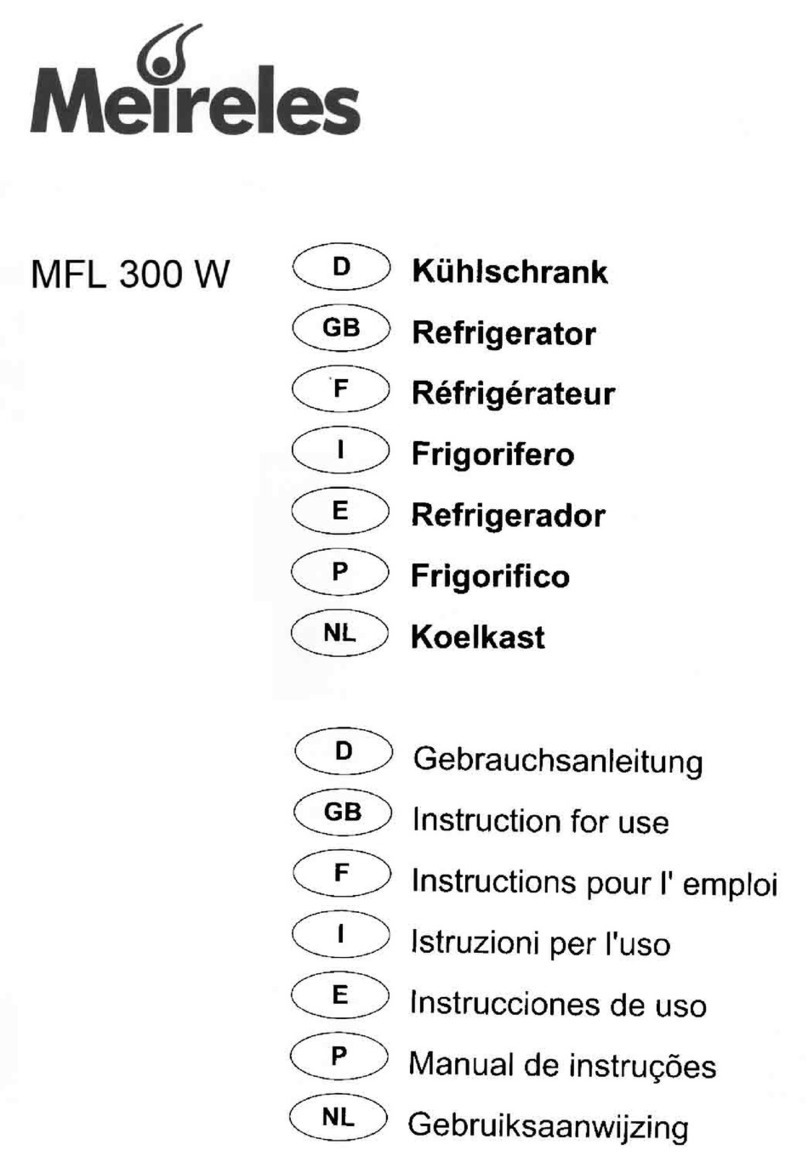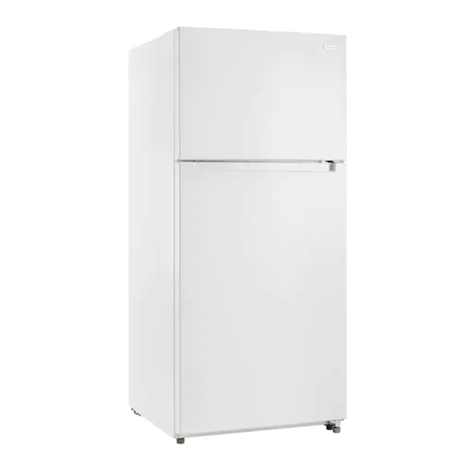New World NW801LA Guide

1
Installation and User Instructions
NW801LA
Integrated Larder
Built In
Retention of the Instruction Book
This Instruction Book must be kept handy for reference as it contains important details on
the safe and proper use of the appliance.
If you sell or pass the appliance to someone else, or move house and leave it behind,
make sure this Book is also provided so the new owner can become familiar with the
appliance and safety warnings.

2
Your New Integrated Appliance
Using your new integrated appliance is very simple. Nevertheless, to get the best results it
is important that you read right through this handbook before using your integrated
appliance for the first time.
Electrical Requirements
WARNING: This appliance must be earthed.
Fuses
Your appliance comes fitted with a plug and a 13A fuse. If you need to replace the fuse,
only those rated at 13A and ASTA approved to BS1362 should be used. If you lose the
fuse cover, a replacement may be obtained from your local authorised Service Centre or
Electricity company. Correct replacement is identified by colour coding or the marking on
base of plug.
WARNING: Do not use plug unless fuse cover is fitted.
Changing the Plug
Cut off and dispose of the supplied plug if it
does not fit your socket.
WARNING: To avoid a shock hazard do
not insert the discarded plug into a
socket anywhere else.
IMPORTANT: WIRES IN THE MAINS
LEAD ARE COLOURED IN
ACCORDANCE WITH THE FOLLOWING
CODE:
Green/Yellow - Earth
Blue - Neutral
Brown - Live
If you change the plug, the colour of wires
in the mains lead may not correspond with
the colour of the markings identifying
terminals in the plug. You should therefore
wire it as shown.
Green and
yellow (Earth)
wire to terminal
marked ‘E’,
symbol , or
coloured green
and yellow.
Blue (Neutral)
wire to terminal
marked ‘N’ or
coloured black.
13A ASTA
approved
fuse to
BS1362.
Brown
(Live)
wire to
terminal
marked ‘L’
or
coloured
red.
Cord clamp
Changing the Mains Lead
If you have damaged the existing lead or require a longer one a charge will be made. It is
strongly advised that this work is carried out by a qualified electrician.
CE marking certifies that this appliance conforms to the following EEC directives:-
Low Voltage Equipment - 72/23/EEC & 93/68 EEC
Electromagnetic Compatibility - 89/336/EEC, 92/31/EEC & 93/68/EEC
WARNING: AVOID ACCIDENTS TO CHILDREN.WHEN DISCARDING AN OLD FRIDGE
OR FREEZER BE CERTAIN TO MAKE THE LOCK UNUSABLE. IF
POSSIBLE,REMOVE THE DOOR AND DISCARD SEPERATELY.
DO NOT ATTEMPT TO SIT ON TOP OF YOUR APPLIANCE. IT IS NOT DESIGNED
FOR SUCH USE AND YOU COULD INJURE YOURSELF OR DAMAGE THE
APPLIANCE BY SUCH ABUSE.

3
Contents Page
Electrical Requirements 2
Disposal Notes/Technical Safety 3
Installation 4-7
Model NW801LA Get to know your Integrated Larder Fridge 8
Getting your Integrated Larder Fridge ready for use 9
Controlling the Temperature 9
Storing Food 10
Do’s & Don’ts 11
Caring for your Integrated Larder Fridge 12-13
If your Integrated Larder Fridge Won’t Work 14
After Sales 15
Guarantee 16
Key Contacts Back Cover
Disposal Notes:
The packaging is designed to protect the appliance and individual components during
transport and is made of recyclable materials.
Corrugated board/board
Moulded polystyrene (foamed, CFC-free polystyrene.
Polythene bags and sheets
Polyproplene straps
Keep packaging materials away from children - polythene sheets and bags can
suffocate!.
Please return packaging material to your nearest official collection point so that the various
materials can be reused or recycled as far as possible.
Ensure that the refrigerant circuit is not damaged, before the appliance that is no longer
needed is taken away for disposal. In this way the refrigerant will not escape into the
environment.
Exact details of the refrigerant used can be found on the type plate.The heat insulator is
PU with Pentane.
Information on collection dates or collection points can be obtained from the waste disposal
authorities or local council.
Technical Safety
The refrigerant R600a is environmentally friendly but flammable, take care not to damage
the refrigerant circuit pipes. If refrigerant does escape, immediately ensure that the area is
well ventilated.
Do not use electrical appliances; i.e ice makers, inside the appliance.
In the event that the appliance is damaged, contact the supplier immediately before
connecting to the mains.
To guarantee safe operation, ensure that the appliance is set up and connected as
described in these operating instructions, and that any repairs and work on the appliance
are only carried out by an authorised service office.

4
INTRODUCTION
Your New World Integrated Larder Fridge
Thank you for purchasing a New World Larder Fridge. Its stylish and practical design will
enhance your kitchen.
Getting Help
If you have any problems with installation, operating or cooking with your New World fridge
please check through these instructions thoroughly to make sure that you have not missed
anything. If you still need help, then please contact (including a daytime telephone number
if possible):
Customer Care Centre
Stoves,
Stoney Lane
Prescot
Merseyside
L35 2XW
NEW WORLD HELP LINE Tel: 0870 444 9939
Please quote the model and serial number with your enquiries. This can be found on the
rating label, positioned on the rear panel
WARNING! For your own safety, make sure that these instructions on installation,
use and maintenance are followed.
We advise you to keep these instructions in a safe place for future reference.
If you sell or transfer ownership of this product, please pass on these instructions to the
new owner.
Note: the pictures shown in the figures in this handbook are purely indicative.

5
Installing Your Integrated Appliance
Please read through this section before
starting any work.
The installation location should be in a dry,
well ventilated room. The appliance should
not be exposed to direct sunlight and
should not be near a heat source (e.g. a
radiator, cooker). If required, use an
insulating plate.
Warning!
The appliance contains the environmentally
friendly but flammable refrigerant R600a.
Ensure that the refrigerant circuit is NOT
damaged during transportation and
installation.
Leaking refrigerant may ignite or cause eye
injuries.
The more refrigerant in an appliance, the
larger the room must be in which the
appliance is situated. If a leak occurs in a
room which is to small, a flammable gas-air
mixture may form.
The room must be at least 1 m3 per 8g of
refrigerant.The amount of refrigerant in
your appliance is indicated on the rating
plate located inside the appliance, on
the bottom left hand side.
If refrigerant is leaking out:
•Avoid naked flames and ignition sources
near the installation location.
•Unplug the appliance and thoroughly
ventilate the room for several minutes.
Installation of the appliance under the
worktop
Although you will need to provide all tools
required for the installation, all fittings are
supplied with the appliance.

6
Installing Your Integrated Appliance
Before fitting
The electrical socket should be easily accessible.
Do not connect the appliance to the electricity supply until installation is completed.
Make sure that the appliance is sitting level on the floor by adjusting all four feet.

7
Changing over the door hinges
Before fitting, if needed, change over the way the door opens as show below.

8
Fastening the appliance under the
worktop.
Secure the appliance bracket under the
worktop by two fixing screws.
Mounting the kitchen cabinet door.
Remove the top bracket from the appliance
and secure to the door panel.
Minimum door width - 595mm
Minimum door height - 650mm
Fitting the door panel to the appliance.
Adjusting the base.
Cut out the plinth of the cabinet to match
the aplliance bottom ventilation grille.

9
Get to know your Integrated Larder Fridge
Model
NW801LA
NW801LA FEATURES:
1 Shelf
2 Defrost water outlet
3 Crisp tray and serving tray
WARNING: CHILDREN SHOULD NOT BE ALLOWED TO PLAY WITH THE
APPLIANCE OR TAMPER WITH THE CONTROLS.
1. Shelf
The shelves are adjustable and can be
pulled out and used on any of the guide
slots. They can also be used in a tilted
position to allow the safe storage of bottles,
jars etc. on there sides. To tilt a shelf, place
the back of the shelf on a lower slot than
the front.
2.The defrost water outlet
The interior of the refrigerator is cooled with
a cooling plate incorporated in the rear wall.
Under the plate there is a channel and an
outlet for the defrosted water.
Regularly check the outlet and channel for
food deposits which could clog the drain
hole. If the hole is blocked, use a plastic
straw to clean it out.
3. Crisp tray and serving tray
The tray at the bottom of the refigerator is
covered with the serving tray. This cover
protects stored food from excessive drying.
The door liner
The door liner consists of various shelves
or holders used for storing eggs, cheese,
butter and yogurt as well as other small
packages, tubes, cans etc.
The lower shelf is used for storing bottles.
The interior light
The light will come on when the door is
opened.

10
Getting your Integrated Larder Fridge
Ready for Use
Before using your Integrated Larder Fridge for
the first time the interior, including the door and
all removable parts should be wiped out. Use a
damp cloth wrung out in either a solution of
one teaspoon of bicarbonate of soda to one
pint of water, or Milton sterilising fluid diluted
according to the manufacturer’s instructions.
WARNING: NEVER USE ANY HOUSEHOLD
CLEANER OR DETERGENT, ABRASIVE
POWDERS OR WAX POLISH.THESE NOT
ONLY DAMAGE THE SURFACES,THEY
ALSO LEAVE A SMELL IN THE LARDER
FRIDGE.
Final Check
Before you start using the Larder Fridge, check
that:
1. It is thoroughly dry inside
2. Air can circulate freely
3. The feet have been adjusted, ie the feet are
firmly on the ground and ensure the appliance
is level.
Starting
Insert the plug into the wall socket and switch
on the electricity supply. Open your Larder
Fridge door and the light will come on. There is
a control dial on the right hand side of Larder
Fridge interior. Turning the temperature
selector dial from ‘0’ (off ) towards ‘7’ to the
medium setting ‘4’. You will hear a noise as the
compressor starts up.
Running in the Compressor
Your Larder Fridge is operated by a
compressor which switches on and off in order
to maintain the Larder Fridge’s temperature.
The compressor is a precision piece of
machinery like a car engine and requires a a
running in period of up to two months. During
this time the compressor has to work a little
harder and this may result in more noise than
usual.
Temperature selection
* Higher settings on the knob (towards 7)
mean lower temperatures. temperature
in the interior of the appliance may even
drop below 0°C.
When the ambient temperature is
normal, we recommend the medium
setting (4).
* The temperature in the refrigerator is
affected by how often the door is opened
and the amount of fresh food recently
stored.
* In the (off) position, the appliance does
not operate (the cooling system is
switched off). The power supply to the
interior light will not be affected and the
light will operate when the door is
opened.
Tips for energy saving
* Try not to open the door to often.
* Check that air is circulating properly through
the plinth grille. (e.g. the grille is not blocked or
covered).

11
Storing Food
You can store most fresh foods in your Integrated Larder Fridge. Recommended maximum
storage times are given in the table below.
Days
Raw fresh meat joints,steaks, chops 3-5
offal (liver, kidney etc) minced meat, sausages 2
Cooked meat including made up dishes and left overs 2-3
Poultry fresh whole (store giblets separately) 2-3
cooked 2-3
giblets 2
Fish raw 1-2
cooked 2-3
Bacon 7-10
Milk, Cream, Salad; vegetables 3-4
Weeks
Butter,Margarine and cooking fats 3-4
Cheese hard 3-4
cream 1
Eggs 2
All foods should be wrapped or covered to prevent drying out and flavour transference.
Plastic bags, containers with lids, foil and plastic stretch wrap are ideal. Never put hot or
warm food into your Larder Fridge as this reduces efficiency.

12
Do’s and Don’ts
DO
Do:- Take off any unsuitable leaves on
vegetables and wipe off any soil.
Do:- Leave lettuce, cabbage, parsley and
cauliflower on the stem.
Do:- Wrap cheese firstly in greaseproof
paper and then in a polythene bag
excluding as much air as possible.
For best results take out of the
fridge an hour before eating.
Do:- Wrap raw meat and poultry loosely
in polythene or aluminium foil. This
prevents drying.
Do:- Wrap fish and offal in polythene
bags.
Do:- Wrap foods which have a strong
odour or can dry out in polythene
bags, aluminium foil or place in
airtight containers.
Do:- Wrap bread well to keep it fresh.
Do:- Chill white wines, beer, lager and
mineral water before serving.
Do:- Make sure that the gutter at the
back of the interior of the Larder
fridge is always clear. Check
regularly and remove any particles
of food which may collect there.
Do:- Keep raw meat and poultry below
cooked food and dairy products.
Do: Clean out the salad bins regularly
and check that nothing has dripped
into them.
Do:- Keep food for as shorter time as
possible and adhere to ‘sell by’
dates.
DON’T
Don’t:- Store bananas in your Larder
fridge.
Don’t:- Store melon in your Larder Fridge.
It can be chilled for short periods
as long as it is wrapped to avoid it
flavouring other products.
Don’t:- Wash eggs as this removes their
natural protective film. Wipe them
instead.
Don’t:- Use eggs straight from the Larder
Fridge, especially when making
cakes or mayonnaise. Allow them
to reach room temperature before
use.
Don’t:- Leave the door open for long
periods as this will make the
Larder Fridge more costly to run.
Don’t:- Cover the shelves with any
protective materials which may
obstruct air circulation through
them.
Don’t:- Let anything touch the cooling
plate at the back of the Larder
Fridge.
Don’t:- Try to keep frozen food which has
thawed; it should be eaten within
24 hours.
Don’t:- Store poisonous or any dangerous
substances in the Larder Fridge.
Your Larder Fridge has been
designed for the storage of edible
foodstuffs only.
Don’t:- Consume food which has been
stored for an excessive time in the
Larder Fridge.
Don’t:- Put hot or warm food straight into
the Larder Fridge.
Don’t:- Let food juices drip onto other
foods in the Larder Fridge.

13
Caring for your Integrated Larder Fridge
Cleaning your Integrated Larder Fridge
It is a good idea to clean the inside of your
Larder Fridge regularly. Always switch off
at the socket outlet and pull out the
mains plug first.
Remove any food.Wipe out the inside of
the Larder Fridge using a clean cloth wrung
out in either a solution of one teaspoon of
bicarbonate of soda to one pint of water, or
Milton diluted according to the
manufacturer’s instructions.
The complete interior including the door,
and removable parts, should be washed
with care ensuring that the cloth does not
become caught on any part of the
appliance. Never use any household
cleaner or detergent, abrasive powders or
wax polish. These not only damage the
surfaces, but also leave a smell in the
Larder Fridge.Make sure that no particles
of food are left in the interior gutter.
If the drain hole becomes blocked it may be
cleared by pushing the end of a pipe
cleaner or drinking straw through the drain
hole and gently moving it up and down.
The rubber door seal must be cleaned
with soap and water only as a detergent
will damage it.
Automatic defrosting
The refrigerator requires no defrosting,
since the ice at the rear wall melts
automatically when the compressor is off
and water slides downwards through the
hole in the rear wall.
This is collected in a receptacle placed at
the bottom of the appliance.
Going Away
If you expect to be away for any length of
time and don’t want to use your Larder
Fridge, switch off at the power point and
pull out the plug. Remove all food and wipe
out the interior. Always leave the door ajar
to prevent the accumulation of odours.
How to Replace the Interior Light
Should the light fail to work, switch off at
the power point and pull out the plug.
Remove the shelves to make access
easier. Access to the bulb is from the rear
of the cover(arrow 1) and remove the
cover in the direction of (arrow 2).
Unscrew the old bulb. Screw the new bulb
securely into the holder.
Replace the plug in the power point and
switch on. If the light fails to work, do not
worry, it will not affect the working of your
Larder Fridge.
Obtain a replacement (max 15 watt 220-
240V alternating current, E14 lampholder)
from your nearest Spares Centre and
replace the old bulb.
Please contact our Customer Care Centre
for a replacement on:
0870 444 9939.

14
Caring for your Integrated Larder Fridge
Cleaning the condenser
Make sure the appliance is
disconnected from the power supply.
Dust from the condenser should be
vacuumed as follows;
* Through the plinth grille, release the
fastener.
* Pull the grille towards you and remove it.
* Remove the bottom board of the kitchen
cabinet.
* Pull the condenser dish out.
* Use the vacuum cleaner to clean the dust
from the condenser.
* Replace the condenser dish and the grille
in the opposite order.
After cleaning, connect the appliance to the
power supply and reload it.
Periodical cleaning of the condenser.
Make sure the appliance is
disconnected from the power supply.
In order to optimize the operation of the
appliance and save energy, it is
recommended to periodically clean the
dust from the condenser at the back of
the appliance.
* Empty the contents of the appliance.
* Remove the supporting panel from the
bottom of the kitchen cabinet.
* Remove the screws fixing the appliance
to the kitchen worktop.
* Pull the appliance out and expose the
condenser at the back of the appliance.
* Unscrew the screws from the condenser
cover and remove the cover.
* Clean the dust and dirt from the
condenser.
After cleaning,refit the appliance back in
position, turn the power supply back on and
reload.

15
If your Integrated Larder Fridge Won’t Work
.....Don’t Panic!!!
Just run through these quick checks before
calling your nearest Service Office.
1. Check that the plug is firmly in the wall
socket and that the power supply is on.
2. Check the power supply to the socket by
plugging in another appliance.
3. If the other appliance works, check the
fuse in the Larder Fridge’s plug.
4. If you have changed the plug, check the
wiring (see page 2).
5. Make sure the appliance is switched on
(the thermostat knob is not in the OFF
position)
6. If there is excessive noise or vibration,
ensure the Larder Fridge is raised fully
to touch the underside of the worktop.
Normal noises may be heard such as;
gurgling and the flow of liquid, this may
be louder when the appliance is first
switched on.
7. If the interior light fails to work, refer to
page 12 for further instructions.
8. If water appears on the inside floor or
under the salad bins, check that the
gutter drain hole has not become
blocked, the drain hole may be cleared
by pushing the end of a pipe cleaner or
drinking straw through the drain hole
and gently moving it up and down. (NB
Water droplets on the cooling plate or
back wall are normal).
If, after following all these instructions, you
are still having problems, contact your
nearest New World Service Agent

16
SERVICE
Please check your guarantee card for who to contact for service. Remember that service
agents may charge for visits (even during the guarantee period) if nothing is found to be
wrong with the appliance, so always check the instructions to make sure you have not
missed anything.
New World Customer Care Centre
Tel: 0870 444 9939
Before contacting a service agent, please note the following details about your cooker:
Model Number............................................
Serial Number ............................................
Date of Purchase .......................................
In order to provide a complete service history for your New World product, please ask the
service engineer to record the appropriate details in the chart below.
Date Nature of fault Parts Replaced or Repaired Authorised Stamp or Signature
New World, Stoney Lane, Prescot, Merseyside, L35 2XW
NW801LA June 2004
HPI 1566 142572/en (11-05)
Table of contents
Other New World Refrigerator manuals
